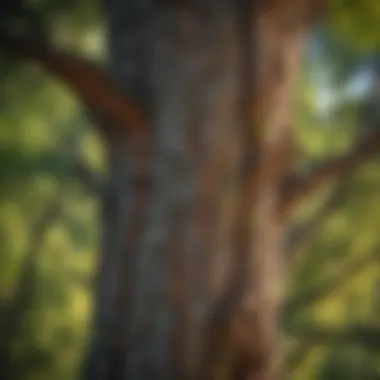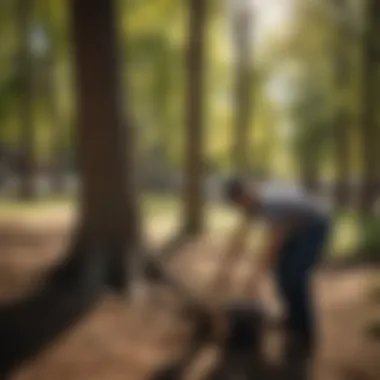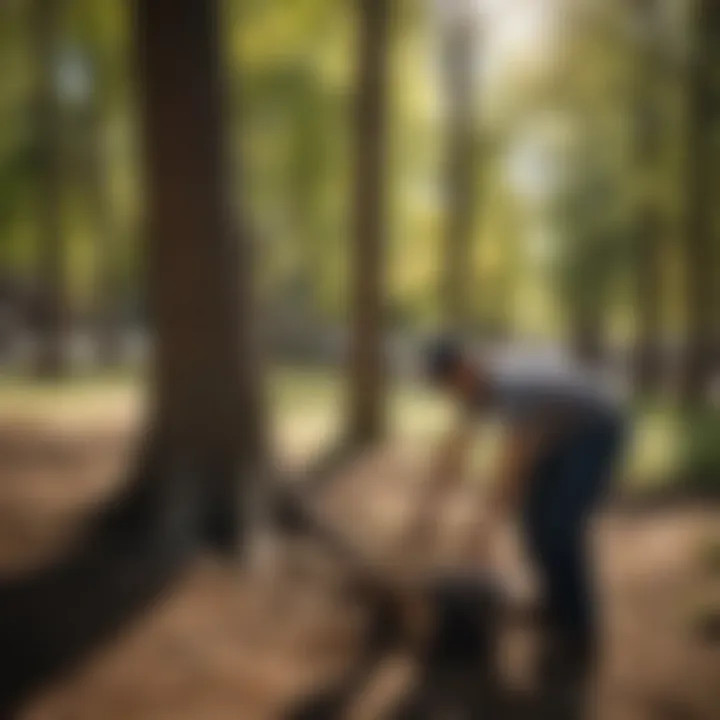Exploring Denver's Diverse Urban Trees


Intro
Denver, Colorado, boasts a rich diversity of trees that contributes to its unique ecosystems and urban landscape. The trees found in this city are not just mere components of nature; they play vital roles in the ecological health of the area. This article thoroughly examines the various tree species present in Denver, focusing on their environmental significance, cultural heritage, and community efforts to preserve and expand forestry in urban settings.
Recognizing the value of urban trees is crucial in contemporary discussions about environmental management. Trees enhance biodiversity and offer numerous benefits, from improving air quality to providing shade and habitat for wildlife. The interplay between urban development and natural systems is a complex issue that requires careful consideration from both residents and forestry professionals alike.
Understanding Woodland Ecosystems
Importance of Biodiversity in Forests
Biodiversity within forest ecosystems is essential for maintaining ecological balance. In Denver, the variety of tree species supports various forms of life, contributing to a resilient environment. A diverse tree population can better withstand diseases and pests. Additionally, different species contribute distinct benefits, such as soil stabilization and carbon sequestration.
An increased biodiversity is also critical for organisms at different trophic levels. It enhances genetic diversity, which can lead to greater adaptability to changing conditions. Trees like the Colorado Blue Spruce and the Ponderosa Pine showcase the ecological variability found in Denver’s forests.
Role of Forests in Climate Regulation
Forests play a significant role in regulating the climate. Trees absorb carbon dioxide, a primary greenhouse gas, thereby mitigating climate change. Urban areas, including Denver, benefit from this effect as they experience increased levels of emissions due to transportation and industry.
Furthermore, forests help in cooling urban heat islands, which can make cities feel significantly hotter than surrounding areas. This cooling effect can be vital in combating heat-related health issues during peak summer months.
Sustainable Forestry Practices
Principles of Sustainable Forestry
Sustainable forestry practices are necessary for balancing ecological health with urban development. In Denver, these practices emphasize the responsible management of tree populations to ensure that they thrive for generations to come. Following principles such as protecting natural habitats, promoting native species, and ensuring a diverse age structure in forests helps achieve these goals.
Case Studies of Successful Implementations
Cities implementing sustainable forestry practices have observed measurable improvements in overall tree health and community awareness. For example, Denver’s Urban Forest Program encourages residents to participate in tree planting events, which not only beautify neighborhoods but also reinforce a culture of stewardship.
Such case studies demonstrate the effectiveness of community engagement when it comes to sustainable practices. They also provide a blueprint for other cities looking to foster healthier urban environments.
Woodland Stewardship Techniques
Forest Management Plans
Effective forest management plans serve as roadmaps for maintaining the health of urban forests. These plans typically include assessments of existing tree health, species inventories, and strategies for addressing issues like pest infestations or invasive species. For Denver, maintaining a balanced and healthy tree population is paramount to the city’s ecological integrity.
Conservation Strategies
Conservation strategies can greatly enhance urban forestry initiatives. Programs aimed at protecting endangered species, restoring native habitats, and promoting public education all contribute to the sustainability of tree populations in Denver. These initiatives often rely on partnerships between local government, nonprofit organizations, and community volunteers.
The importance of community involvement in forestry cannot be overstated; informed citizens can significantly enhance the preservation efforts.
Preamble to Trees in Denver
Trees play a significant role in urban environments, and Denver, Colorado, is no exception. This city’s trees not only enhance the aesthetic value of its neighborhoods but also contribute to ecological sustainability and global environmental goals. Understanding the dynamics of trees in Denver is critical for urban forestry practitioners, policymakers, and residents alike. The importance of these trees can be observed through their effects on climate, air quality, and overall community wellbeing.
Importance of Urban Trees
Urban trees are vital for several reasons. First, they improve air quality by filtering pollutants. Trees absorb carbon dioxide and release oxygen, contributing positively to the urban atmosphere. Additionally, they offer shade, which helps in reducing heat during hot summer months. This is particularly important in Denver, where the climate can drive temperatures to uncomfortable levels.
Moreover, trees play essential roles in stormwater management. Their roots absorb rainwater, reducing runoff and lessening the risk of urban flooding. This is especially advantageous in Denver, where rain patterns can be erratic.
The social impacts of urban trees are equally notable. They contribute to increased property values and enhance the quality of life in communities. Public parks and tree-lined streets encourage outdoor activities, promoting healthier lifestyles. Communities with ample trees often report a greater sense of well-being among residents, making these trees invaluable assets.
Denver's Unique Climate
Denver's climate presents unique challenges and opportunities for urban forestry. The city is characterized by a semi-arid climate, which means it experiences hot summers and cold winters. This climate influences the types of trees that can thrive in the environment. Species adapted to withstand drought conditions are often favored in urban planning.


Additionally, Denver’s elevation at approximately 5,280 feet creates a specific set of environmental conditions. Higher altitudes can lead to more intense sunlight, which can impact tree growth and health. Furthermore, the city often experiences temperature fluctuations that can be detrimental to certain tree species. Therefore, selecting resilient tree varieties is essential for ensuring a sustainable urban forest.
In summary, the introduction of trees in Denver is multifaceted and crucial for both ecological balance and community welfare. Their importance can’t be overstated, as they serve both environmental functions and provide social benefits that contribute to the city's overall health.
Historical Context of Tree Planting in Denver
Understanding the historical context of tree planting in Denver offers significant insights into the evolution of urban forestry practices. It provides a lens through which we can view environmental management and cultural values associated with trees in this urban setting.
Often, cities evolve in response to a combination of growth pressures, cultural trends, and environmental challenges. Denver's approach to its urban forest reveals how society's values have shifted over time. Recognizing this history helps contemporary society make informed decisions regarding tree planting and care practices, contributing to ecological sustainability and community well-being.
Early Settlement and Forestry Practices
When the first settlers arrived in the Denver area in the mid-19th century, the landscape was predominantly characterized by native grasses and sparse trees adapted to the arid climate. The initial communities established in Denver focused on agricultural practices, often favoring the cultivation of plants that would provide immediate utility to the settlers.
The early settlers understood the importance of tree planting, mainly for shade, fuel, and building materials. They planted species that were familiar to them, allowing them to create a familiar environment in the new land.
Moreover, these early efforts were also driven by necessity. The harsh climate required trees to mitigate wind and provide some protection during storms. Notably, settlers favored cottonwoods, which thrived in the river valleys and became a defining tree of the area.
Evolution of Urban Forestry Policy
As Denver grew into a major urban center, the significance of trees continued to evolve. The late 19th and early 20th centuries witnessed changes in urban forestry policy. Early attempts to create parks and green spaces highlighted the emerging understanding of trees' roles in urban planning.
In 1900, the establishment of Denver's park system included intentional tree planting. The city recognized that trees were crucial for air quality, aesthetic appeal, and overall quality of life. Over the years, policies shifted to become more formalized, addressing not only the planting but also the maintenance of urban trees.
"Effective urban forestry policies are foundational for ensuring that trees meet ecological and community needs for generations to come."
By the late 20th century and into the 21st century, there has been a push towards enhancing urban forest management practices. This includes integrating community input, prioritizing native species, and addressing challenges such as climate change and development pressures. From reactive policies born out of necessity to proactive strategies that engage communities, Denver's forestry policies illustrate a comprehensive approach to maintaining the city's urban forest.
The historical context of tree planting in Denver highlights how societal values surrounding trees have evolved. Today, these trees are recognized not only for their immediate benefits but also for their long-term contributions to ecological resilience and community vibrancy.
Diversity of Tree Species
The diversity of tree species in Denver is a crucial aspect of the urban ecosystem. Each species contributes uniquely to the ecological balance, supporting biodiversity while enhancing the aesthetic and functional qualities of urban landscapes. Many factors influence this diversity, including climate, soil types, and human activity. Understanding these elements can aid in the management and conservation of Denver's trees, ensuring they thrive amid environmental challenges.
Native Trees of Colorado
Native trees play a vital role in maintaining the ecological integrity of Denver. Species such as the Rocky Mountain Juniper and the Ponderosa Pine are adapted to local conditions, offering resilience against pests and diseases. Their root systems help prevent soil erosion, enhancing water retention.
Moreover, native trees provide habitats for various wildlife, including birds and insects. The presence of these species increases the overall biodiversity, which is essential for healthy ecosystems. They also require less maintenance and fewer resources, making them cost-effective and sustainable options for urban forestry.
Commonly Planted Urban Trees
Urban areas in Denver feature a mix of tree species, many of which are strategically chosen for their adaptability and aesthetic appeal. Commonly planted trees include the Norway Maple, Silver Maple, and American Elm. These species are popular not only for their rapid growth but also for their ability to withstand urban stressors, such as pollution and compacted soils.
Planting diverse species mitigates the risks associated with tree diseases and climate variability. It also enhances the visual diversity of the landscape, promoting a more inviting urban environment. Proper selection and placement of these trees can improve air quality, reduce urban heat, and create shade for residents.
Rare and Endangered Species
Despite the variety of trees in Denver, certain species are becoming increasingly rare or endangered. The Colorado Blue Spruce, renowned for its striking appearance, faces threats from climate change and urban expansion. This species requires specific growing conditions that are often compromised by city development.
Efforts to protect these rare species are vital. Local organizations often initiate programs aimed at conservation and restoration. Engaging the community in tree planting and educational programs can foster a greater awareness about the importance of these vulnerable trees.
"Conservation of rare tree species is not just an ecological concern, it is a cultural heritage imperative."
In summary, the diversity of tree species within Denver not only reflects its ecological health but also underpins the city's cultural and aesthetic values. Understanding and fostering this diversity is critical for sustainable urban development.
Ecological Role of Trees in Denver
The ecological role of trees in Denver is a critical aspect of the city’s environmental health. Trees provide numerous benefits that extend beyond their aesthetic appeal. These benefits include supporting biodiversity, improving air quality, moderating temperatures, and mitigating stormwater runoff. Urban trees function as a crucial part of local ecosystems, enhancing the overall quality of life for residents.
Biodiversity Support


Trees are vital for supporting biodiversity in urban settings. They provide habitats for various species, including birds, mammals, and insects. In Denver, the diverse array of tree species creates microhabitats that support a wide range of wildlife. Native trees, such as the Colorado Blue Spruce and Quaking Aspen, contribute to this diversity by offering shelter and food sources. Their presence encourages a balanced ecosystem where different species can thrive.
The loss of trees in urban areas often leads to diminished wildlife populations. In Denver, preserving and expanding tree canopies is essential for maintaining biodiversity. Community initiatives aimed at reforestation and tree planting are crucial. These efforts not only increase tree cover but also enhance wildlife corridors, allowing species to move and interact more freely.
"Urban trees are more than just green spaces; they are lifelines for many creatures."
Pollinator Habitats
Trees also play a significant role in creating habitats for pollinators, such as bees and butterflies. Pollinators are essential for the reproduction of many plants, including those that provide food for both wildlife and humans. By planting trees that provide nectar and pollen, cities like Denver can support healthy pollinator populations.
Species such as the Flowering Crabapple and the Eastern Redbud are particularly beneficial for pollinators. They bloom at different times of the year, offering continuous food sources. It is important to select the right tree species when planning urban landscapes to optimize pollinator support. This careful consideration not only fosters biodiversity but also promotes a healthy ecosystem.
In summary, the ecological role of trees in Denver cannot be overstated. Their contributions to biodiversity support and the provision of pollinator habitats underscore the importance of urban forestry in maintaining ecological balance. These trees are integral to the health of urban ecosystems, serving both wildlife and the people who live in the city.
Challenges Facing Urban Trees
The challenges faced by urban trees in Denver are multifaceted and significant. Understanding these challenges is crucial for maintaining the health of the city’s urban forestry. Tree populations directly affect urban ecosystems, providing shade, improving air quality, and supporting biodiversity. Yet, each of these benefits is at risk due to a range of environmental and human-induced factors. Furthermore, a thriving urban tree canopy can enhance community pride and improve property values. Therefore, addressing these challenges is essential for the overall well-being of Denver's urban landscape.
Climate Change Effects
Climate change poses a significant threat to urban trees in Denver. Rising temperatures and shifting precipitation patterns can stress trees, particularly those that are not native to the region. Many tree species may struggle to adapt to increased heat and prolonged drought conditions. For example, the shift towards more frequent and severe weather events can lead to sudden flooding or drying out of soils, which is damaging for root systems.
Additionally, warmer winters can influence tree dormancy cycles, causing them to break dormancy too early. This premature growth can make trees more susceptible to late frosts, leading to damage that would not occur under normal climatic conditions.
"The future of urban forestry relies heavily on adaptive measures to combat the influences of climate change."
Prolonged drought conditions are also significant. Trees require a stable water supply for growth and resilience. As water resources become scarcer, competition for irrigation in urban areas can intensify. Finally, tree mortality rates can increase due to heat stress and inadequate water, jeopardizing both urban biodiversity and the benefits trees provide.
Pests and Diseases
Urban trees often fall victim to pests and diseases that can threaten their longevity and health. The dense concentration of trees in urban environments can create ideal conditions for pests to thrive. The emerald ash borer, for instance, has wreaked havoc on ash trees across Denver, leading to extensive removals and prompting an urgent need for management strategies.
Moreover, diseases such as Dutch elm disease and oak wilt threaten different species, potentially leading to significant losses in tree diversity. Urban trees are more vulnerable due to various stress factors, including poor soil quality, limited space for root growth, and pollution, which can weaken their immune responses.
Strengthening the health of urban trees is essential. Measures such as regular health assessments and timely interventions can help in early detection of these pests and diseases. This not only maintains the urban canopy but also preserves broader ecosystem integrity.
Urban Development Pressures
Urban development presents a continuous pressure on the tree population in Denver. Expanding infrastructure, housing, and commercial areas often leads to tree removal or displacement. This not only reduces the number of trees but also fragments existing green spaces, diminishing their ecological functions.
The design and planning of new developments need to incorporate green spaces where tree planting is possible. Urban planners can include native species that are more resilient to urban stressors. Community engagement is necessary in these planning processes. Residents should advocate for trees even in the face of development pressures, as the benefits provided by trees must be emphasized to city officials.
In summary, addressing these challenges can significantly improve the condition of urban trees in Denver. From implementing effective climate adaptation strategies to enhancing community involvement in urban forestry, proactive measures are necessary to ensure the survival of this essential resource.
Community Involvement and Stewardship
Community involvement and stewardship play a crucial role in the sustainability and health of urban trees in Denver. Engaging local residents fosters a sense of ownership and responsibility for tree care. This engagement not only enhances the physical landscape but also strengthens community bonds. By cultivating a collective awareness about the significance of trees, community members can influence city policies and support conservation efforts.
Active participation in tree stewardship leads to various benefits. First, it helps protect local biodiversity. Native species thrive better with community support, leading to healthier ecosystems. Additionally, volunteers often educate themselves, enhancing their knowledge about the ecological roles that trees play. This shared understanding can drive further community initiatives and advocacy for tree preservation. Furthermore, increased community engagement can promote mental health and well-being, as green spaces contribute to reduced stress and improved quality of life.
The impact of community involvement in urban forestry cannot be overstated. It represents a vital component of effective environmental stewardship, ensuring that efforts are both sustainable and inclusive. Understanding and actively contributing to local tree conservation can empower citizens, helping to shape a resilient urban forest for future generations.
Local Organizations and Initiatives
Many organizations in Denver work tirelessly on tree preservation, education, and community engagement. These groups have established diverse initiatives designed to involve residents in hands-on activities related to urban forestry.
Organizations such as the Denver Urban Forestry Division focus on planting and maintaining trees in public spaces. They often conduct educational workshops that range from proper planting techniques to identifying tree diseases. Another notable initiative is Groundwork Denver, which offers programs designed to involve youth in learning about and maintaining their local environment.
Additionally, the TreeUtah program emphasizes tree planting projects that enhance both community spaces and environmental health. Their efforts include hostings events where community members come together to plant trees in designated areas. This creates a communal spirit with shared goals and responsibilities.


Volunteer Opportunities
There are numerous volunteer opportunities available for those interested in contributing to urban forestry in Denver. Participating in these initiatives can provide hands-on experience in tree care and environmental stewardship.
Both Denver Parks and Recreation and Denver Botanic Gardens regularly host volunteer days for tree planting and maintenance. These events are open to individuals and families, making it easy for anyone to get involved.
Individuals can also consider joining local initiatives such as the Arbor Day Foundation, which encourages people to plant trees in their own communities. Further, street tree stewardship programs often seek volunteers to help care for trees within their neighborhoods.
Innovative Practices in Urban Forestry
Urban forestry is vital for the health and sustainability of city landscapes. Implementing innovative practices in this field helps communities adapt to changing environmental conditions. Denver, with its unique challenges, benefits significantly from these advanced approaches. Notably, these practices enhance tree resilience, promote biodiversity, and engage the public in stewardship.
Sustainable Planting Techniques
Sustainable planting techniques focus on selecting appropriate species that thrive in Denver’s specific environmental conditions. Mulching is one essential method that retains moisture and protects tree roots from temperature fluctuations. Additionally, using native species minimizes the need for extensive maintenance and irrigation. Before planting, soil testing is crucial. It informs amendments needed for optimal growth, ensuring trees have a strong foundation.
Moreover, adopting proper spacing between trees allows for air circulation and sunlight, which are critical for growth. This technique also helps prevent the spread of diseases. In Denver, planting during the optimal season—late spring or early fall—further boosts survival rates. Community workshops can teach residents the importance of these methods and encourage involvement in local planting efforts.
Technological Advances in Forestry
Technological advances play a crucial role in the management of urban forestry. Drones are increasingly used for aerial surveys of tree canopies. These tools offer data on tree health, allowing for targeted intervention. Additionally, geographic information systems (GIS) help map tree distribution and assess biodiversity. This technology supports strategic planning for future plantings and helps identify areas in need of more vegetation.
Furthermore, mobile applications have emerged that allow citizens to report tree health issues or pest outbreaks. This real-time data collection helps municipal agencies respond quickly to threats that could harm the urban forest. Overall, these innovations enable better decision-making, ensuring Denver’s trees remain healthy and vibrant for future generations.
"Engaging technology not only enhances tree management but also fosters community involvement through real-time reporting and monitoring."
Looking Ahead: The Future of Trees in Denver
The future of trees in Denver is a critical aspect of urban planning and environmental sustainability. The city boasts a relatively unique ecological profile, which requires carefully thought-out strategies for tree management and conservation. Urban forests serve dual purposes: they enhance the beauty of the city while delivering essential ecological services like air purification and biodiversity support.
Developments in climate science and urban forestry are vital for maintaining these trees. The city aims to continue improving its green infrastructure to deal with ongoing challenges such as climate change and urban development. A sustainable future depends on robust urban forest management plans and effective climate resilience strategies.
Urban Forest Management Plans
Urban forest management plans are integral in shaping the future of Denver's trees. These plans outline the goals, strategies, and actions necessary for fostering a healthy and diverse urban forest. They prioritize species selection, tree planting locations, and overall forest structure management. In Denver, this means understanding local tree populations, assessing their health, and devising intervention strategies when needed.
Effective management can have multiple advantages:
- Preservation of Biodiversity: Ensuring a mix of native and non-native tree species can help support local wildlife.
- Resilience to Pests and Diseases: Diverse urban forests can mitigate the impact of pests and diseases.
- Community Engagement: Involving local residents in tree planting and maintenance fosters community stewardship and awareness of urban forestry issues.
Furthermore, these plans must consider socio-economic factors. Trees affect property values and can significantly enhance quality of life.
Strategies for Climate Resilience
As climate change poses increasing risks, strategies for enhancing climate resilience among urban trees are essential. The focus here should be on adaptable tree species, robust planting techniques, and ongoing community education. In Denver, various strategies can support growing a resilient urban forest:
- Select Climate-Resilient Species: Identifying tree species that can withstand fluctuations in temperature and precipitation will be critical.
- Implement Multilayered Canopy Designs: A layered approach ensures that there are trees of varying heights and types, optimizing sunlight and resource use.
- Regular Monitoring and Data Collection: Continuous assessment of tree health allows for timely interventions to remediate potential issues before they escalate.
"Investing in our urban forest is investing in the sustainability of our community. We must act now to ensure a future where trees thrive alongside urban development."
In summary, focusing on effective urban forest management and strategizing for climate resilience will play significant roles in shaping the future of Denver's trees. By addressing these issues comprehensively, the city can ensure the health and longevity of its urban forest for generations to come.
Epilogue
Concluding an in-depth exploration of the trees in Denver, Colorado, we underscore the vital role these urban trees play not only in the local ecosystem but also in the social fabric of the community. The focus of this article has been on the diversity of tree species, their ecological significance, and the various community initiatives aimed at promoting urban forestry.
Trees contribute to climate regulation, support biodiversity, and enhance urban aesthetics. Their presence helps in reducing urban heat, improving air quality, and preventing soil erosion. Understanding these benefits can drive policies that protect and expand tree populations. Additionally, appreciating the cultural significance of trees can enhance community ties and foster a sense of stewardship among residents.
Summary of Key Insights
- Biodiversity: Trees in Denver host a range of wildlife, supporting both plant and animal species that thrive in urban settings.
- Cultural Value: Urban trees contribute to Denver's identity, offering historical and aesthetic value that connects the community to its past.
- Community Engagement: Local organizations play a pivotal role in educating the public about the importance of trees and providing volunteer opportunities for residents to directly impact urban forestry efforts.
- Sustainable Practices: Adoption of innovative urban forestry strategies fosters resilience against climate challenges, ensuring the longevity of tree populations in Denver.
- Support for Policy: Effective urban forest management plans are essential for addressing the ongoing challenges posed by pests, diseases, and urban development.
Call to Action for Community Engagement
Given the insights shared, it is imperative for residents, policymakers, and organizations to actively engage in tree preservation and planting efforts. Here are several actionable steps:
- Join Local Organizations: Participate in groups like Denver Digs Trees or similar initiatives. These organizations coordinate planting events and foster educational programs about tree care.
- Volunteer: Opportunities for community involvement abound. Volunteering for tree planting and maintenance activities helps directly in urban forest management.
- Advocate for Urban Forestry: Communicate with local government officials about the importance of maintaining urban trees. Support policies that prioritize green spaces.
- Educate Others: Sharing knowledge about the benefits of trees within social circles raises awareness and promotes community responsibility.
- Participate in Workshops: Attend workshops focused on sustainable tree care practices to better understand how to support the local urban forestry initiatives.







